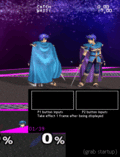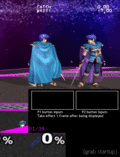| Welcome to SmashWiki! Log in or create an account and join the community, and don't forget to read this first! |
| Notices |
|---|
| The Skill parameter has been removed from Smasher infoboxes, and in its place are the new "Best historical ranking" and "Best tournament result" parameters. SmashWiki needs help adding these new parameters to Smasher infoboxes, refer to the guidelines here for what should be included in these new parameters. |
| When adding results to Smasher pages, include each tournament's entrant number in addition to the player's placement, and use the {{Trn}} template with the matching game specified. Please also fix old results on Smasher pages that do not abide to this standard. Refer to our Smasher article guidelines to see how results tables should be formatted. |
| Check out our project page for ongoing projects that SmashWiki needs help with. |
Button mashing
Button mashing refers to the act of quickly pressing various controller inputs in rapid succession. In fighting games (including the Super Smash Bros. series), while this usually carries a negative playstyle connotation, some gameplay mechanics intentionally implement is as a feature to aid players affected by them. For example, rapidly pressing buttons allows characters to escape situations like being stunned, grabbed, or frozen more quickly, which is extremely useful to reduce the amount of time they are left vulnerable to attacks.
Button mashing can also refer to repeatedly pushing the same input (or spamming), such as mashing the special button when firing Fox's Blaster. Spamming can prolong many attacks, and may also be used to increase the frequency, range, or duration of others. When precise timing is not required, mashing is often the fastest and most reliable way to go. Less advanced players may choose to mash with techniques like dodging in order to increase their chances of success. From Brawl onward, the buffer system makes this kind of button mashing more useful to execute actions as early as possible.
Overview
Generally, while a character is affected by a condition that can be influenced by button mashing (such as getting grabbed or stunned), each input reduces the duration of said condition by a specific amount of frames, so the faster a player can mash buttons, the sooner they can escape. As inputs can be registered every frame, or up to 60 times per second, the fastest button mashing possible is effectively impossible for human players to achieve; instead, humanly feasible mashing speeds tend to register inputs every 3 or 4 frames at their fastest, or between 15 and 20 inputs per second. Notably, level 9 CPUs can often transcend this execution barrier and button mash at a frame-perfect speed. For example, if a character is initially grabbed for 180 frames (3 seconds), and each input reduces this duration by 8 frames, the grab lasts 20 frames (1/3 of a second) if an input occurs every frame, or 60 frames (1 second) if an input occurs every 4 frames.
Any button assigned to a character action can be used for button mashing, with the exception of the C-Stick (aside from Brawl) and taunt buttons. In the case of the control stick, the four cardinal directions are considered separate inputs, so the player can simply spin the control stick for a sizable amount of mashing. However, the same input cannot be registered in consecutive frames, as this is considered by the game as holding the input. As a result, optimal mashing often involves alternating between various inputs, though this can also have other restrictions depending on the game.
In Super Smash Bros. Melee and Super Smash Bros. Brawl, there is no visual indicator for a button mashing, other than a character's grab hold animation in Melee playing slightly faster when used to escape a grab. Super Smash Bros. 4 adds an indicator for characters mashing out of a bury by having them shake in the spot, though it remains invisible for other conditions. Super Smash Bros. Ultimate expands more significantly on this by displaying wind blade-like particles around a character button mashing out of any applicable condition, with the particles increasing in quantity depending on their mashing speed; additionally, mashing out of stun causes the animation to play faster, much like with grabs in Melee.
Restrictions
In Super Smash Bros., Melee, and Brawl, control stick and button inputs are treated separately. Each frame only allows one stick input and one button input to be registered, but it is still possible to combine both, allowing for two inputs per frame. Therefore, the most optimal button mashing in these games generally involves spinning the control stick while alternating between two buttons.
In Smash 4, button mashing is generally weaker than in previous games. It is no longer possible to register stick and button inputs in conjunction, allowing for only one input per frame instead of two. Additionally, buttons assigned to the same action (such as the X and Y buttons to jump by default) are counted as the same input, and thus cannot be alternated every frame. Furthermore, button inputs have a different effect on mashing than stick inputs; their effectiveness is increased by 1.8× compared to stick inputs, but any subsequent input (including a stick input) is registered in 2 frames, instead of the frame right after. For example, if the default reduction by mashing for a grab is 8 frames, stick inputs still reduce its duration by this amount, but button inputs reduce it by 14.4 frames each; however, as only one button can be input in the same time as two stick inputs, they are slower by themselves. Because of this, optimal mashing in Smash 4 generally only focuses on spinning the control stick as fast as possible, with button inputs serving as an occasional aid in case a stick input is missed.
Ultimate keeps the button mashing mechanics from Smash 4, with one additional restriction for button inputs: while inputs assigned to the same action can still be registered every 2 frames, alternating between inputs for different actions causes them to be registered every 3 frames instead, even if the next one is a stick input[1]. As a result, simply spinning the control stick as fast as possible remains the most optimal mashing strategy.
Conditions affected by mashing
Several conditions or effects can be influenced by button mashing, chiefly those that restrain the affected character's control. In all games where they appear, unless otherwise stated, button mashing can reduce the duration of the following conditions:
- Being held in a grab (except in Smash 64, where the grab has a set maximum duration and automatically transitions into a forward throw).
- Once a throw is initiated, it cannot be escaped by button mashing, with the exception of Donkey Kong's forward throw carry in all games (including Smash 64), and Kirby's forward and back throws in Melee.
- The following command grabs can also be affected by mashing:
- Bowser's Koopa Klaw in Melee.
- Diddy Kong's Monkey Flip.
- Ganondorf's aerial Flame Choke in Ultimate.
- King Dedede and Kirby's respective Inhales; can be used to escape faster both when swallowed and when spat out as a star.
- Lucario's Force Palm.
- Ridley's Space Pirate Rush.
- Robin's Nosferatu; button mashing has a weaker effect as the target's damage percentage increases, becoming completely ineffective at 120% or higher.
- Steve's Minecart.
- Wario's Chomp; causes the throw to execute faster instead of forcing a grab release.
- Yoshi's Egg Lay; cannot be used to escape the grab itself, but reduces the time the victim is trapped in an egg.
- Being asleep, buried, frozen, or stunned (including from a shield break).
- Having the flower effect.
- Having a Pikmin latched on by Olimar's Pikmin Throw.
- Getting pinned by Corrin's Dragon Lunge; cancels the pin and causes the victim to be knocked down.
- Getting caught by the Barrel Cannon, Beetle, or Boss Galaga items, as well as the Arcade Bunny's crane.
- Getting caught by The Fish in the Summit or Balloon Fight stages, as well as the barrels in the Wrecking Crew stage.
- Getting caught by some bosses' grab-based attacks, such as Master Hand's crush attack from Melee onward, or Galleom's grab in Ultimate.
While functionally similar to the above, the following conditions are not affected by button mashing:
- The duration of hitstun or any kind of ending lag (including Jigglypuff's Rest, which is often mistakenly thought to be affected by button mashing because of the sleeping animation).
- Having another object such as a C4, Crash Bomber, or Gooey Bomb latched on.
- Getting paralyzed or crumpled.
- Being affected by Bayonetta's Witch Time.
- Having a poison or curse effect.
- Being covered in ink.


